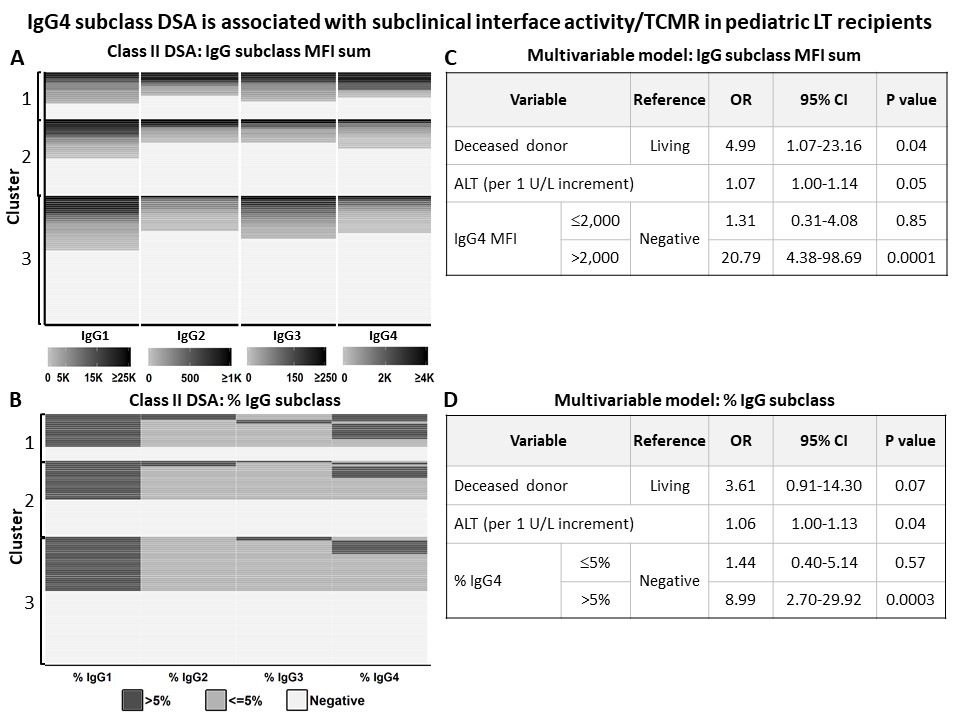IgG4 Subclass Class 2 Donor Specific Antibody (DSA) is Associated with Subclinical Rejection in Stable Pediatric Liver Transplant (LT) Recipients with Normal Liver Tests
1Surgery, Duke University, Durham, NC, 2The Immune Tolerance Network, Bethesda, MD, 3Immune Tolerance Network, Bethesda, MD, 4Medicine, Johns Hopkins University, Baltimore, MD, 5Pathology, University of Pittsburgh, Pittsburgh, PA, 6Surgery, University of California San Francisco, San Francisco, CA
Meeting: 2019 American Transplant Congress
Abstract number: 41
Keywords: HLA antibodies, Liver, Pediatric, Rejection
Session Information
Session Name: Concurrent Session: Liver: Immunosuppression and Rejection
Session Type: Concurrent Session
Date: Sunday, June 2, 2019
Session Time: 2:30pm-4:00pm
 Presentation Time: 2:42pm-2:54pm
Presentation Time: 2:42pm-2:54pm
Location: Room 312
*Purpose: DSA is a known biomarker of allograft rejection, yet injury phenotype and potential differ across organs. Among pediatric LT recipients entering iWITH (NCT01638559), an immunosuppression withdrawal trial, eligibility biopsies segregated into 3 histological phenotypes (Feng et al. Gastroenterology, 2018). We investigated DSA IgG subclass and assignment to Cluster 1, characterized by interface activity and tissue gene expression profile of T-cell mediated rejection (TCMR), vs Clusters 2 (fibrosis alone; no TCMR) or 3 (no inflammation or fibrosis; no TCMR).
*Methods: Sera from 129 subjects (67 boys; 40 living donor) were tested using LabScreen® Single Antigen™ HLA beads, α-IgG and α-IgG subclass-antibodies. DSA defined by HLA epitopes and thresholds of: IgG >2000 MFI and IgG subclass > mean autologous-HLA MFI. Cluster 1 was correlated with clinical and class II DSA features in uni- and multi-variable analyses. DSA IgG subclass sum was examined in 2 ways: absolute MFI and %IgG subclass. %IgGX was calculated by dividing [IgGX MFI] by [IgG1MFI+IgG2MFI+IgG3MFI+IgG4MFI].
*Results: Among 129 subjects, 24 (19%), 39 (30%) and 66 (51%) were assigned to clusters 1, 2 and 3, respectively. 65 subjects (50%) tested positive for total IgG class II DSA. IgG1 was most common, present in 64 or 98% of all subjects, compared to IgG2 (42; 65%), IgG3 (49; 75%) and IgG4 (47; 72%). Cluster 1 vs 2 or 3 had the highest proportion of subjects with IgG4 >2000 MFI (Fig 1A) and ≥5% IgG4 (Fig 1B). Among subjects in Clusters 1, 2 and 3, IgG4 MFI was >2,000 for 37% (9/24), 5% (2/39) and 5% (3/66) while IgG4 was ≥5% for 50% (12/24), 18% (7/39) and 11% (7/66), respectively. In models with deceased donor and ALT, IgG4 MFI (OR 20.79; 95%CI 4.38, 98.69; p=.0001) and ≥5% IgG4 DSA (OR 8.99; 95%CI 2.70, 29.92; p=.0003) were strongly associated with Cluster 1 assignment (Figs 1C+D).
*Conclusions: IgG4 class II DSA was strongly associated with subclinical chronic liver injury characterized by interface activity and a tissue transcriptional profile of TCMR in pediatric LT recipients. IgG4 DSA reflects an evolved humoral response, consistent with the observed chronic injury phenotype. Subclass determination may non-invasively risk-stratify clinically and biochemically stable transplant recipients.
To cite this abstract in AMA style:
Jackson A, Kanaparthi S, Burrell B, Lucas D, Vega R, Demetris AJ, Feng S. IgG4 Subclass Class 2 Donor Specific Antibody (DSA) is Associated with Subclinical Rejection in Stable Pediatric Liver Transplant (LT) Recipients with Normal Liver Tests [abstract]. Am J Transplant. 2019; 19 (suppl 3). https://atcmeetingabstracts.com/abstract/igg4-subclass-class-2-donor-specific-antibody-dsa-is-associated-with-subclinical-rejection-in-stable-pediatric-liver-transplant-lt-recipients-with-normal-liver-tests/. Accessed December 16, 2025.« Back to 2019 American Transplant Congress

